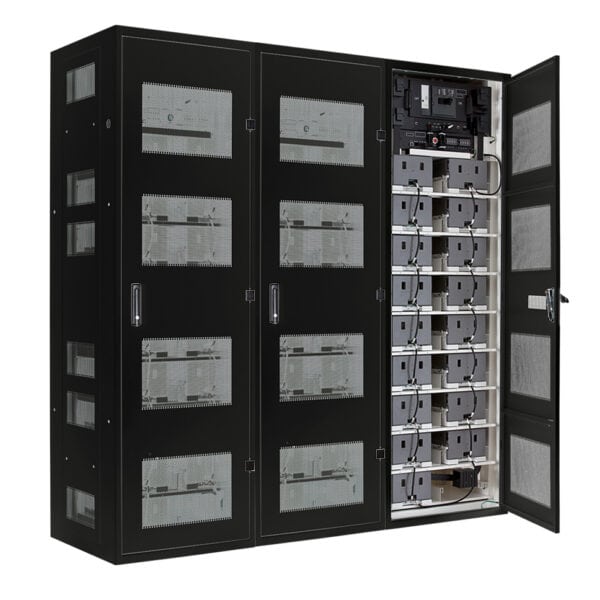The fact that a business installs an uninterruptible power supply (UPS) demonstrates a level of concern regarding their critical load and its continuous supply of clean power. Once the UPS is installed, however, it becomes its own focus of reliability – for what use is it if it fails just when it is needed? In many cases, the result of a UPS failure can be catastrophic – imagine a large data centre, for instance, going offline and the chaos this would cause to credit card companies, banks or other organizations. For this reason, the most critical loads are protected by the very best UPS design – decentralised parallel architecture (DPA). DPA not only provides the best availability, but also the best serviceability, scalability and flexibility. Taken together, these features all deliver a low total cost of ownership (TCO).
Availability
Availability is a measure of how much time per year a system is up and available, and is one of the most important reliability parameters for IT equipment. Power availability is the most significant single component of a system’s availability and is a measure of how much time per year a computer system has acceptable power. Since power problems are the largest single cause of computer downtime, increasing power availability is the most effective way to increase overall system availability.
Power availability has two components: mean time between failures (MTBF) and mean time to repair (MTTR). The two most important issues in increasing power availability are, therefore, increasing the MTBF and decreasing the MTTR of the power protection system.
DPA architecture
UPS systems with a centralised parallel architecture (CPA) have some degree of hierarchical, centralised control or hardware (e.g., static bypass). This renders them very vulnerable should a fault occur on one of these centralised components; one fault can bring down the entire UPS. With DPA, on the other hand, the UPS is modularised and each module has all the hardware and software needed for autonomous operation – rectifier, inverter, battery converter, static bypass switch, back-feed protection, control logic, display, and mimic diagram for monitoring and control. A module’s output is not affected by failures elsewhere in the UPS. If redundancy is provided for then one or more modules can be lost without jeopardising the load. In other words, a multi-module system is fault tolerant and there are no single points of failure. Availability is also maximised.
The only UPS elements common to all modules are contained in the mechanical frame that accommodates the UPS modules – I/O connection, customer interface signalling, maintenance bypass and, in some models, a system display. These elements are non-critical for UPS operation.
DPA – load transfer and load sharing
The CPU in each UPS module continuously monitors the status of its inverter, bypass and loading, and shares this information with the other CPUs. In the event of a fault, the CPU of each module reports the availability of the module’s inverter and bypass to the module system logic. Based on this information, the modules then usually come to a unanimous decision as to whether the critical load should remain on the inverter or be transferred to the bypass. On rare occasions, one or more modules might deviate from the majority decision, in which case the majority decision stands. In the case of a split vote, the load remains on the inverter, as it is a more reliable source than the raw mains power supply.
It can be seen that all modules have equal decision-making power and none of the CPUs is master.
When it comes to load sharing, the situation is different. Here, one module is designated as the master and all the remaining modules are slaves. Crosscurrents between the modules must be avoided in order to ensure a good supply quality so the master’s control circuit continuously monitors the current in each module and, if it has deviated from what it should be, a message is sent to the relevant modules to regulate their current. Should a master module fail, the next module takes over as master.
These DPA decision making and load sharing features are at the core of DPA’s ability to maximise system availability.
Modularity and redundancy
The surest way to increase availability of power is to optimise the redundancy of the UPS system and to minimise its maintenance and repair time. One major advantage of DPA’s modularity is the ease with which redundancy can be accommodated.
If N UPS modules are needed to cover the power needs of a particular critical load, then, often, one extra module is used so that even if one module subsequently fails there are still enough healthy modules left to power the load. This is called N+1 redundancy. Of course, an entire second set of N modules could be held in reserve – this is even more reliable and is called 2N redundancy. To further improve reliability one module extra could be added to each set, giving 2N+1 redundancy, and so on, though 2N+1 is usually quite sufficient to cover most premium reliability and availability requirements.
Scalability
As UPS power requirements change – if a data centre is expanded, for instance – the modular nature of DPA makes it really easy to add modules to increase the power capabilities. This means that you only cable, power and cool what you need. Power consumption is the topic of greatest concern for most operators and the energy savings made by the modular approach over the service life of the UPS are substantial.
Hot-swapping and serviceability
Modules can be hot-swapped, i.e., removed or inserted, without risk to the critical load and without the need to power down or transfer to raw mains supply. This unique aspect of modularity directly addresses continuous uptime requirements, significantly reduces MTTR, reduces inventory levels of specialist spare parts and simplifies system upgrades. This approach pays off too when it comes to serviceability and availability – online swapping of modules means you do not have to switch off during replacements, so there is no downtime and the service personnel do not need special skills. Spares can be held on-site or at a nearby KOHLER Uninterruptible Power service centre. Not only does this improve availability but it also reduces cost as service engineers spend less time on-site, and any risks of data or production loss are minimised. Inventory levels of specialist spare parts are reduced, too.
This online-swap technology, as well as having a significant impact on cost, can also help achieve so-called six nines (99.9999 per cent) availability – highly desirable for installations in pursuit of zero downtime.
Energy and space costs
The modularity and scalability described have a major positive impact on achieving a low cost of ownership, but costs are also constrained by DPA designs that have best-in-class energy efficiency. KOHLER Uninterruptible Power’s PW 9500 DPA, for example, operates with an efficiency of up to 96 per cent. Its efficiency curve is very flat so there are significant savings in every working regime. Furthermore, UPS cooling costs can be substantial but because less power is consumed, high-efficiency modular UPSs require less cooling effort, generating further savings.
Modularity lends itself well to keeping UPS footprint small, too – ideal where real estate is limited and expensive. A modular UPS rack has a small footprint and when extra modules are added, no extra floor space is taken up.
Standardised modules
DPA modules are standardised. This keeps costs low: A straightforward, standardised modular concept simplifies and speeds every step of the deployment process – from planning, through installation and commissioning to final use. High-quality standardised products significantly reduce intervention time during maintenance or in the event of failure – components can be changed quickly and easily and service is simplified. The better quality that results from the mass production and testing of standardised modules has a direct positive impact on reliability and, thus availability: modular systems with standardised connections can be pre-wired and field-configured at the factory allowing for more thorough testing, and standardised connections reduce the risk of bad connections in the field – one of the biggest problems during any electrical commissioning. In addition, modular components can be returned to the manufacturer for service, which greatly improves repair quality. The ability to perform factory repair is a significant reliability advantage that leads to a future higher availability of the repaired unit.
DPA highly dependable UPSs are increasingly mission-critical for many parts of industry. Products like the PW 9500 DPA deliver unparalleled UPS availability and the serviceability, scalability, flexibility and low energy usage made possible by the modular DPA approach deliver a very attractive TCO. There are no better UPS architectures available to those users whose critical electrical loads represent a valuable commercial asset that must be kept powered at all costs.


